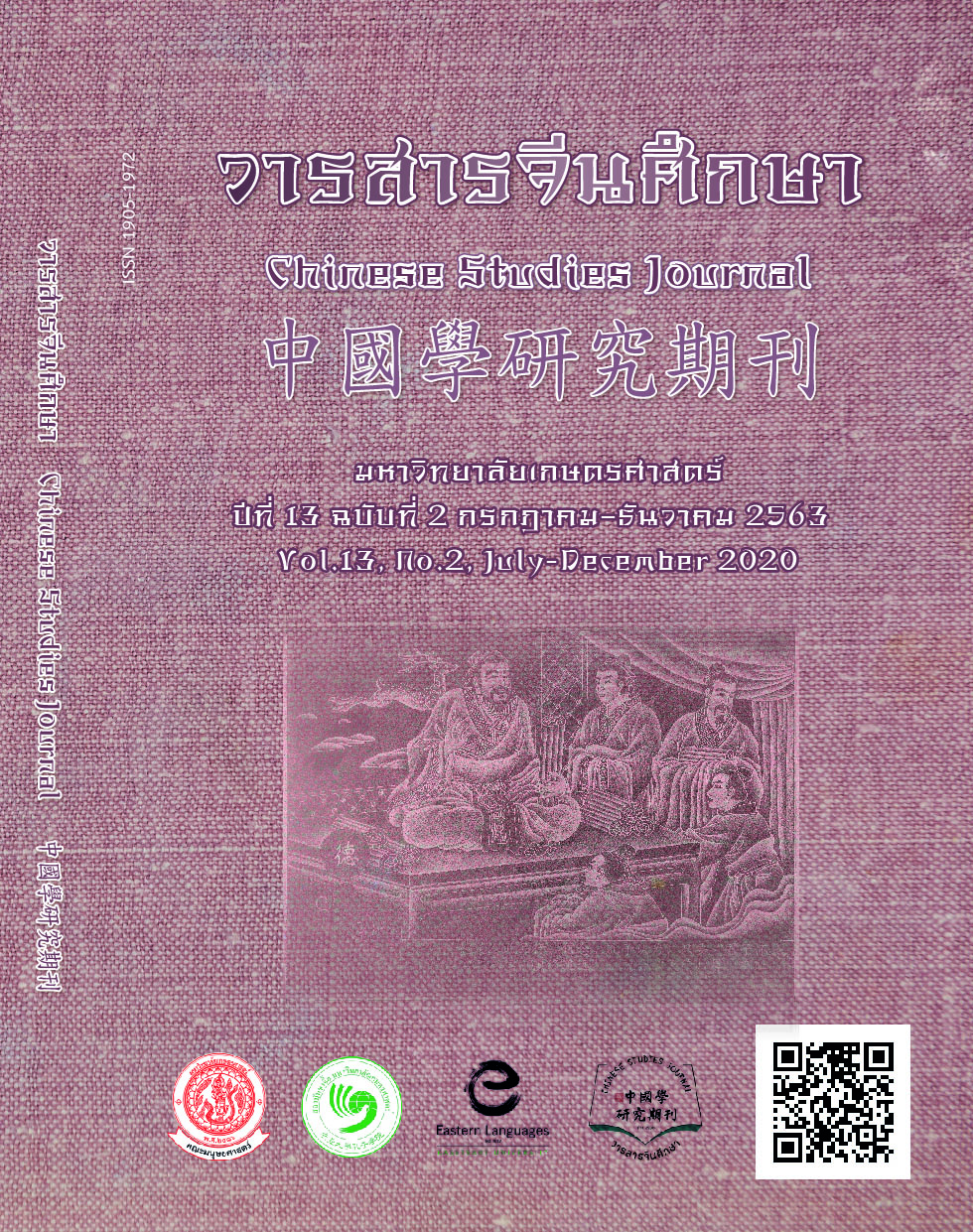The Immigrant Theory and New Chinese Immigrants
Main Article Content
Abstract
Thailand contains one of the largest populations of Chinese immigrants outside of mainland China. Ethnic Chinese account for 11 percent of the Thailand population, some of which can be attributed to an effective assimilation policy implemented by the Thai government in the past, and especially during Phibunsongkhram-Era. It is therefore not surprising that Thailand and China have established such a strong relationship. Both culture and economy are intertwined through trade and exchanges, carried out by both communities.
The roles and status’ of expatriate Chinese people have changed over time. Today’s current and future Chinese immigrants are no longer unskilled compared with the early Rattanakosin period. According to a survey of 119 new Chinese immigrants conducted by the Asian Research Center for Migration (ARCM) of Institute of Asian Studies at Chulalongkorn University in Bangkok, 68.9 percent of new Chinese immigrants who invested in Bangkok start-ups, hold a bachelor degree. To further understand new Chinese immigrants in Thailand we must explore theoretical framework which will assist us to understand their situation.
The phenomenon of new Chinese immigrants has not only occurred in Thailand, but also the larger south East Asian region and indeed the world. The presence of Chinese immigrants in the region has drawn special attention from trade and investment, to politics and security. This paper therefore aims to analyze this phenomenon with the related immigrant theory, in order to gain a better understanding of new Chinese immigrants in Thailand.
Article Details
ผลงานทางวิชาการที่ลงตีพิมพ์ในวารสารจีนศึกษา มหาวิทยาลัยเกษตรศาสตร์ เป็นลิขสิทธิ์ของผู้เขียนหรือผู้แปลผลงานนั้น หากนำลงในวารสารจีนศึกษาเป็นครั้งแรก เจ้าของผลงานสามารถนำไปตีพิมพ์ซ้ำในวารสารหรือหนังสืออื่นได้โดยมิต้องแจ้งให้ทราบล่วงหน้า แต่หากผลงานที่ได้รับพิจารณานำลงในวารสารจีนศึกษา เป็นผลงานที่เคยตีพิมพ์ที่อื่นมาก่อนเจ้าของผลงานต้องจัดการเรื่องปัญหาลิขสิทธิ์กับแหล่งพิมพ์แรกเอง หากเกิดปัญหาทางกฎหมาย ถือว่าไม่อยู่ในความรับผิดชอบของวารสารจีนศึกษา มหาวิทยาลัยเกษตรศาสตร์ ทั้งนี้ ความคิดเห็นต่างๆ ในบทความเป็นความคิดเห็นส่วนตัวของผู้เขียน ไม่เกี่ยวกับกองบรรณาธิการวารสารจีนศึกษา มหาวิทยาลัยเกษตรศาสตร์
References
แรงงานฝีมือ ชาวฟิลิปปินส์ในประเทศไทย. วารสารสถาบันทรัพยากรมนุษย
มหาวิทยาลัยธรรมศาสตร์, 9, 44-60. จาก
http://journalhri.com/pdf/0901_03.pdf (27 ตุลาคม 2562 )
ชาดา เตรียมวิทยาและคณะ. (2016). โครงการ “การตั้งถิ่นฐานของชาวจีนรุ่นใหม่ :
กรณีศึกษาชุมชนจีนแห่งใหม่” “ทฤษฎีความเกี่ยวพัน (Linkage Theory),” (2555),
จาก http://economicsthai.blogspot.com/2012/06/linkage-theory.html
“ทฤษฎีความเกี่ยวพัน (Linkage Theory), ทฤษฏีดุลแห่งอำนาจ (Balance of Power
Theory) และ แนวคิดทางภูมิรัฐศาสตร์,” (2560), จาก
http://studyinternationalaffairs.blogspot.com/2017/08/linkage-theory-
balance-of-power-theory.html (30 ตุลาคม 2562 )
บงกชมาศ เอกเอี่ยม. (2019). การย้ายถิ่นข้ามชาติ : การสร้างและธำรงรักษาเครือข่ายทาง
สังคมของแรงงานพม่าหญิงในเมืองเชียงใหม่.
ประภัศรา แพทย์ดี. (1985). ไทยกับผู้อพยพทางเรือชาวเวียดนาม : วิเคราะห์กระบวนการ
การกำหนดนโยบายและการทูตของไทย. จาก
https://cuir.car.chula.ac.th/xmlui/handle/123456789/34980 (15 พฤศจิกายน
2562 )
พัชรี เจริญธรรม. (2014). ความคิดเห็นของแพทย์โรงพยาบาลมหาวิทยาลัยบูรพา คณะ
แพทยศาสตร์ มหาวิทยาลัยบูรพา ต่อโอกาสการเคลื่อนย้ายแรงงานแพทย์จากการเปิด
ประชาคมเศรษฐกิจอาเซียน. จาก
http://digital_collect.lib.buu.ac.th/dcms/files/54930550/chapter2.pdf
(15 พฤศจิกายน 2562 )
พีรญา คงคาฉุยฉาย, (2549), “ปฏิสัมพันธ์ของพ่อค้าชาวกัมพูชาในพื้นที่การค้าชายแดน :
กรณีศึกษา ตลาดโรงเกลือ จังหวัดสระแก้ว,” (ศิลปศาสตรมหาบัณฑิต), จุฬาลงกรณ์
มหาวิทยาลัย, จาก http://cuir.car.chula.ac.th/handle/123456789/56058.
(15 พฤศจิกายน 2562)
โพสต์ทูเดย์. (2018). จีนสั่งกำชับนักลงทุนปฏิบัติตามกม.ไทย หลังมีข่าวเอี่ยวนำเข้าขยะผิด
กฎหมาย. จาก https://www.posttoday.com/world/554476.
(20 พฤศจิกายน 2562)
ยุพิน คล้ายมนต์, (2536), อิทธิพลวัฒนธรรมจีนที่มีต่อไทย, กรุงเทพฯ: สถาบันเอเชีย
ตะวันออกศึกษา มหาวิทยาลัยธรรมศาสตร์.
รังสรรค์ มณีโรจน์. (2013). การเปลี่ยนแปลงในลิเบียภายหลังปรากฏการณ์ Arab Spring
กับโอกาสของไทย. จาก
http://www.mfa.go.th/dvifa/contents/filemanager/files/nbt/nbt5/IS/IS5027.pdf
(20 พฤศจิกายน 2562)
วิชชุกาญจน์ พาโนมัย. (2013). ปัจจัยที่มีผลต่อการเคลื่อนย้ายแรงงานเข้าสู่ภาคอุตสาหกรรม
ในอำเภอเมือง จังหวัดขอนแก่น. วิทยานิพนธ์ปริญญามหาบัณฑิต,
มหาวิทยาลัยขอนแก่น, คณะ เศรษฐศาสตร์, สาขาวิชาเศรษฐศาสตร์ธุรกิจ. จาก
http://mslib.kku.ac.th/elib/multim/books/Economic2556/WITCHUKAN
%20PANOMAI/06_c h2.pdf (20 พฤศจิกายน 2562)
ศุภรัตน์ เลิศพาณิชย์กุล, หน้า 115, อ้างถึงใน ศุภวรรณ ชวรัตนวงศ์, (2540), “บทบาทของ
ชาวจีนในไทย ตั้งแต่สมัยอยุธยาตอนปลายถึงสมัยรัชกาลที่ 3 แห่งกรุงรัตนโกสินทร์
พ.ศ. 2172-2394,” (อักษรศาสตรมหาบัณฑิต), จุฬาลงกรณ์มหาวิทยาลัย, จาก
http://cuir.car.chula.ac.th/handle/123456789/9276, หน้า 33.
(20 พฤศจิกายน 2562)
ศุภวรรณ ชวรัตนวงศ์, (2540), “บทบาทของชาวจีนในไทยตั้งแต่สมัยอยุธยาตอนปลายถึง
สมัยรัชกาลที่ 3 แห่งกรุงรัตนโกสินทร์ พ.ศ. 2172-2394,” (อักษรศาสตรมหาบัณฑิต),
จุฬาลงกรณ์มหาวิทยาลัย, จาก
http://cuir.car.chula.ac.th/handle/123456789/9276, หน้า 56-128.
(20 พฤศจิกายน 2562 )
สกินเนอร์ จี. วิลเลียม, (2529), “สังคมจีนในประเทศไทย: ประวัติศาสตร์เชิงวิเคราะห์ (พรรณี
ฉัตรพลรักษ์, ผู้แปล),” กรุงเทพฯ: มูลนิธิโครงการตำราสังคมศาสตร์และมนุษยศาสตร์,
หน้า 3-31.
สมชาย หาญหิรัญ. (ม.ป.ป.). แนวคิดการเลือกที่ตั้งอุตสาหกรรม. จาก
http://harnhirun.com/ebooks/industry/files/basic-html/page4.html
สุทธิพร บุญมาก, และมูหำหมัด สาแลบิง. (กันยายน-ตุลาคม 2019). ความเป็นนานาชาติของ
สถาบันอุดมศึกษาที่เป็นเงื่อนไขต่อการย้ายถิ่นแรงงานระหว่างประเทศ: แรงงาน
ไทยเชื้อสายมลายู ระดับทักษะจากจังหวัดชายแดนภาคใต้สู่ประเทศมาเลเซีย.
Humanities, Social Sciences and arts, 12, 1124-1139. จาก
https://he02.tci-thaijo.org/index.php/Veridian-E-
Journal/article/view/170997/151365. (15 พฤศจิกายน 2562 )
สุภางค์ จันทวานิช. (2008). ผลกระทบของการย้ายถิ่นข้ามชาติต่อชุมชนชายแดนและ
ชุมชนที่มีผู้ย้ายถิ่น จํานวนมากในประเทศไทย: การสร้างความกลมกลืนและ
ความมั่นคงในชมชน. จาก
http://library.senate.go.th/document/Ext12/12612_0004.PDF
(20 พฤศจิกายน 2562)
หทัยเทพ กีรติอังกูร. (2018). แนวทางการบูรณาการเพื่อป้องกันและแก้ไขปัญหาแรงงาน
ต่างด้าวตามแนวชายแดนไทย – กัมพูชา. จาก
http://www.dsdw2016.dsdw.go.th/doc_pr/ndc_2560-
2561/PDF/8582st/%E0%B8% A3%E0%B8%A7%E0%B8%A1.pdf
(25 พฤศจิกายน 2562)
อรัญญา ศิริผล. (2018). การเคลื่อนย้ายของคนจีนกับบทบาทรัฐจีนในศตวรรษที่ 21. ใน
คณะสังคมวิทยาและมานุษยวิทยา มหาวิทยาลัยธรรมศาสตร์ (บรรณาธิการ), ชีวิตทาง
สังคมในการเคลื่อนย้าย (Social Life on the Move) (น.115-145). นนทบุรี: โรง
พิมพ์ภาพพิมพ์.
อุษามาศ เสียมภักดี. (ม.ป.ป.). การย้ายถิ่นระหว่างประเทศ พัฒนาการและแนวคิด. จาก
https://www.stou.ac.th/Schoolnew/polsci/UploadedFile/82227-3.pdf
John Crawfurd, (1935), pp.103, อ้างถึงใน สกินเนอร์ จี. วิลเลียม, (2529), “สังคม
จีนในประเทศไทย: ประวัติศาสตร์เชิงวิเคราะห์ (พรรณี ฉัตรพลรักษ์, ผู้แปล),”
กรุงเทพฯ: มูลนิธิโครงการตำราสังคมศาสตร์และมนุษยศาสตร์, หน้า 19.
PPTV Online. (2019). ไกด์ไทยร้องตำรวจถูกคนจีนแย่งอาชีพ. จาก
https://www.pptvhd36.com/news/%E0%B8%9B%E0%B8%A3%E0%
B8%B0%E0%B9%80%E0%B8%94%E0%B9%87%E0%B8%99%E0%B8%
A3%E0%B9%89%E0%B8%AD%E0%B8%99/53630
(25 พฤศจิกายน 2562)
曾少聪,曹善玉.(2005).华人移民研究. 东南亚研究,01:110-115.
陈建荣.(2008).泰国新移民的群体特征——曼谷地区新移民个案研究. 东南
亚研究,04:71-76.
庄国土.(2008).“论中国人移民东南亚的四次大潮,” 南洋问题研究 .1:
69-81.
John Crawfurd.(1828).pp.138, 239, cited in 庄国土. (2008).“论中国
人移民东南亚 的四次大潮,” 南洋问题研究. 1:69-81, :71. 释
义为 “19 世纪初出使暹 罗的英人柯罗福说‘: 旅客是从中国到暹罗
的最重要的输入’‘ , 一只戎克船一次送 1,200个中国人到曼谷’,
每年到曼谷的中国人少说有7,000人。据他估计, 到了1821 年, 暹罗
已有中国人70万。”
Dimmock & Leong, Studying overseas : Mainland Chinese students in
Singapore, November 2010.Hein de Haas. (2011). The determinants of
international migration: Conceptualising policy, origin and
destination effects. Retrieved from
https://www.ilo.org/dyn/migpractice/docs/225/Determinants.pdf
(20 พฤศจิกายน 2562)
King, Russell. (2012). Theories and Typologies of Migration: An Overview
and a Primer. Retrieved from
https://www.researchgate.net/profile/Russell_King3/publication/
260096281_Theories_and_Typologies_of_Migration_An_Overview_and
_A_Primer/links/0 a85e52f8c2ce19850000000/ Theories-and-Typologies-
of-Migration-An-Overview-and-A- Primer. pdf?origin=publication_detail
p.13. (15 ธันวาคม 2562)
Parritta Wangkiat, (2016, September 18), “The quiet Chinese revolution,”
Bangkok Post, Retrieved from
https://www.bangkokpost.com/thailand/special-reports/1088793/the-
quiet-chinese-revolution (15 ธันวาคม 2562)
Piore. Michael J. (1983). Labour Market Segmentation: To What Paradigm
Does It Belong? The American Economic Review, 73(2), 249 -253.
(15 ธันวาคม 25662)
Rashid Faridi. (2018). Migration Theories: Lee’s Push Pull Theory.
Retrieved from
https://rashidfaridi.com/2018/04/05/migration-theories-lees-push-pull-
theory/ (20 ธันวาคม 2562)


